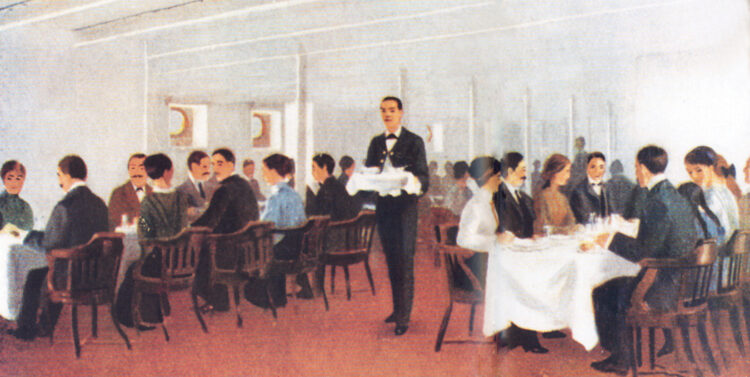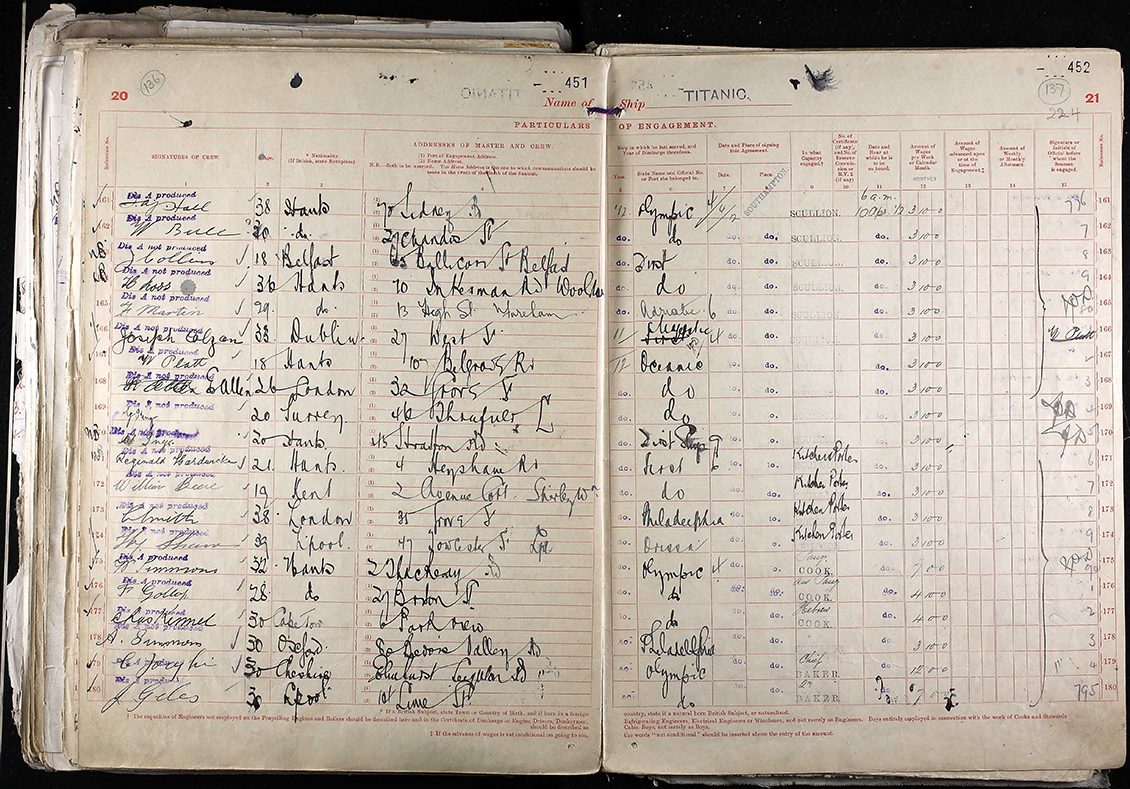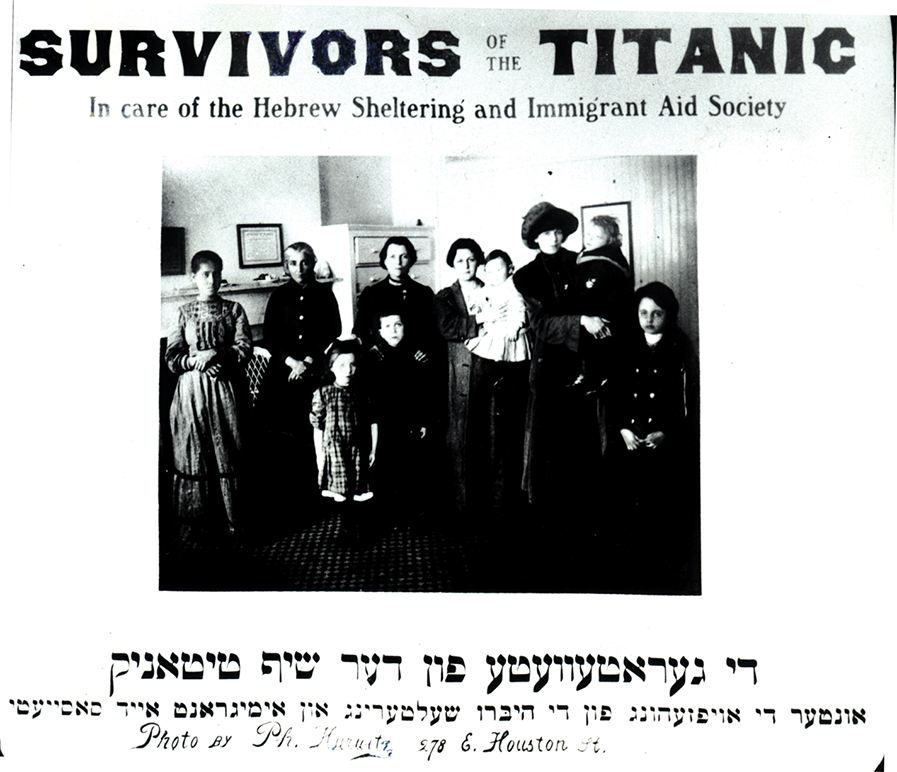Kosher Titanic

Availability of kosher food sheds light on immigration via England
By Marshall Weiss, The Dayton Jewish Observer
Of the 2,225 people aboard Titanic on its maiden voyage, 1,512 perished in the frigid waters of the North Atlantic when the ship went down in the early hours of April 15, 1912.
Charles Kennel was among the nearly 700 crew members to die that night. Born in Cape Town, South Africa, the 30-year-old Kennel signed on to the White Star Line’s Titanic on April 4, 1912. He listed his address as 6 Parkview, Southampton, the port city in southeast England from which the Titanic would embark.
Kennel had already served on the Titanic’s sister ship, the Olympic, which took its maiden voyage in 1911. Now he came aboard the larger, more luxurious Titanic for wages of four pounds a month. Kennel was the ship’s “Hebrew cook.” The Titanic had kosher food service.
Midway through the great wave of Eastern European Jewish immigration to America — which brought two million Jews to the United States between 1881 and 1924 — major passenger lines crossing the Atlantic began instituting kosher food service for their Jewish passengers, mainly immigrants in third-class steerage.
But historians and authors who explore and preserve the body of knowledge about Titanic know little else about kosher food and Jewish life aboard the ill-fated liner.
“It’s been a very tough subject to get much on,” said Charles Haas, president of the Titanic International Society. “My research has generated more questions than answers. It’s been, in a way, frustrating because I haven’t been able to find anybody who knows for sure almost anything.”

Haas and John Eaton are authors of five books on Titanic including the meticulous Titanic: Triumph and Tragedy, which has just been released in a newly expanded third edition.
Over the years, they’ve cultivated friendships with Titanic survivors and their descendants, conducted Titanic research in England and Northern Ireland, and have plunged to the ocean floor to see the Titanic’s wreckage.
The two will be among the guest lecturers on the Titanic Memorial Cruise from Southampton to New York, April 8-19 aboard the Balmoral cruise ship.
The White Star and Cunard lines, as well as the German lines all had kosher facilities by the time Titanic sailed, Haas said.
Based on information Haas has found about kosher kitchens on other ocean liners of the time — particularly on Titanic’s sister ship Olympic — he believes, “we have some probably reasonable assumptions in terms of Titanic.”

The earliest reference Haas has found about kosher service on an ocean liner dates to 1904.
“There’s an article in the Trenton Times in June 1904 and it says, among other things, ‘American Line officials arranged another innovation in the form of special kosher cooks for the Jews. The English will have their meals served separately and their cabins will also be separate from those of the Jews.’ And that was on the S.S. Philadelphia.”
One of the big names in shipbuilding at that time, Haas said, was Albert Ballin, chairman of the Hamburg-American Line. In 1905, Ballin, who was Jewish, decided to place separate kosher facilities on all of his steamships between New York and Bremen.
According to a contemporary news article about the Hamburg-American line, the addition of kosher service was “in accordance with a request from a number of representative Jewish organizations.”
Valery Bazarov, director of family history and location services for HIAS, the Hebrew Immigrant Aid Society, also confirmed the first decade of the 20th century as the beginning of kosher food service on liners crossing the Atlantic. He added that HIAS, which continues to help resettle Jewish refugees to America, established a kosher kitchen at Ellis Island in 1911.
Jewish steerage passengers on Titanic — as was the case on other liners departing from England for America — were primarily refugees from Eastern Europe. But why would they stop over in England first?
“To get out of immediate danger, and more than that,“ Bazarov explained. “It was not only immediate danger like a pogrom; it was also immediate danger if someone was drafted to the Russian army.”
Transmigrants through Britain
A century ago, the term of conscription to the Russian army was three mandatory years. Bazarov referred to conscription as “the underground pogrom, only much longer and much more painful.”
The Jews of Eastern Europe, he added, were limited in their successes because of pervasive antisemitism. “It was not just immediate danger but just the quality of life as a whole,” he said, that also led them to flee.
“To travel abroad, all Russians, not only Jews, needed foreign passports,” Bazarov said. “And to get it, they wrote a petition to the local authorities. They needed to bring the certificate about their relationship to the military service. Without that, they wouldn’t be allowed.”
That’s why so many Eastern European Jews forged or purchased forged passports, he said.
Some Jews fled to England because they couldn’t afford the ocean passage; some tried to make lives for themselves there. Others were required by law to keep moving.
“Even at that time, two stop-overs cost less than a ‘direct flight,’ like now,” Bazarov said.
England’s National Archives has estimated that between 1881 and 1905, up to 100,000 Eastern European Jews settled in England. Parliament curtailed this immigration in 1905 with the Aliens act. Most Eastern European Jews could then only stop over in England as “transmigrants,” on their way to other destinations.
The British National Archives has also estimated that between 1880 and 1914, approximately one million Jewish transmigrants arrived at England’s eastern ports, crossed the country “quickly,” and departed via England’s western ports.
Before liners offered kosher food, Jews who kept kosher had to fend for themselves, bringing their own food. Some didn’t survive. Despite the Jewish value of pikuach nefesh — that saving a life takes precedence even over keeping kosher — Haas cited a Washington Post article from Nov. 2, 1909 about Gisella Greiner, a “young Hebrew immigrant,” who died of starvation in Ellis Island’s hospital. Kosher food was not available during her nine-day voyage across the Atlantic; she chose to fast.
Even for those passengers who didn’t keep kosher, food service in the old steerage system could be a vile experience.
In December 1909, the U.S. Immigration Commission reported on steerage conditions to the U.S. Congress. The report described the “disgusting and demoralizing conditions of the old steerage,” in which 300 or more people would sleep in large compartments. There were no regular dining rooms for steerage class. A minimum number of tables and seats were set in common areas.
An immigration commission agent described the sleeping compartment of one of these liners as subdivided into three sections: “one for the German women, which was completely boarded off from the rest; one for Hebrews; and one for all other creeds and nationalities together. The partition between these last two was merely a fence, consisting of four horizontal 6-inch boards. This neither kept out odors nor cut off the view.”
That particular liner did have a separate galley and cook for kosher food. “They used the same tables with others if they used any, and were served in the same manner,” the agent reported. “Their food seemed of the same quality.”
It was competition for steerage passengers, the 1909 report continued, that led the major lines to develop improved steerage conditions.
Haas said, the “new steerage” arrangements of the White Star Line, particularly those of Olympic and Titanic, provided third-class passengers with foods they had neither seen nor could ever afford before, such as oranges.

“The White Star Line, although we tend to think of them as the steamship line of luxury, they really catered to the third class, because they made more per head on the third class tickets than they did on a first-class,” Haas said. “And if they could get word-of-mouth advertising where immigrants reached America and wrote home and said how wonderfully they were treated on the White Star Line’s ships, that was the best kind of advertising they could hope for.”
On Olympic and Titanic, Haas said, the largest cabins in third class accommodated six. In some cases, there were cabins for four and even two.
“The third class, in most cases, were accustomed to waiting on others,” Haas said. “And here for the first time they had stewards serving them. And there’s even a notice on the bottom of the menu saying, ‘any complaints regarding the lack of civility from a steward should be reported to the chief steward immediately.’”
As in all steerage arrangements of the time, Titanic’s third-class passengers were segregated by gender. The men were in the bow of the ship, unmarried ladies in the stern, and families were also in the stern.
Haas, who is not Jewish, has attempted to track down details of Titanic’s kosher facilities while conducting research in Belfast, where the Titanic was built, at Harland and Wolff shipyard. He’s never seen a kosher-only menu card specific to Titanic.
“All of the existing menus for the Titanic, to the best of my knowledge, there’s not specific reference to that,” Haas said. “I don’t know whether that would have been done by word of mouth or it might possibly have been at the time passengers booked their tickets.”
He and Eaton have seen a generic 1911 White Star third-class menu that indicates the availability of kosher meat. The menu was part of an advertisement for Olympic.
“In terms of artifacts that have been retrieved from the ocean floor,” he said, “we’ve not seen any kosher service dinnerware, although we do know from the Olympic, what the design (for dishes) looked like and everything.”
Karen Kamuda, vice president of Titanic Historical Society Inc. and Titanic Museum in Indian Orchard, Mass., said in an e-mail that her understanding of kosher food service on Titanic comes from Paul Louden-Brown, a former society vice president and author of The White Star Line, An Illustrated History.
She explained that on Titanic, all kosher “china, stoneware and silver-plate or other serving utensils were marked in Hebrew and English either ‘meat’ or ‘milk.'” The same standards, she indicated, “applied for all classes, and even first class silver-plate was marked ‘milk’ or ‘meat.’ Kamuda added that “rabbis regularly inspected the liners’ catering departments in both Southampton and New York.”
A few clues
Eaton, Haas’ writing partner, puzzles at the scarce documentation of kosher service aboard the Titanic.
“There are fundamental questions of when and who decided to hire a ‘Hebrew Cook’ for Titanic’s kitchen,” he explained in an e-mail. “Who and when were (which) Jewish authorities called in for consultation? For the actual implementation of the facility…the ‘victualizing’ inventory for the Titanic is well known: all sorts of cookware as well as serving plates and tableware are categorized and listed. But nowhere is there any mention of or separate designation for ‘kosher’ items.”

But Eaton did remember that about 20-25 years ago, likely at the Ulster Folk and Transport Museum in Holywood, Northern Ireland, he caught a brief glimpse of a Titanic deck plan that included a space indicated by an arrow for kosher service.
“It was a small space as I recall,” he said, “scarcely large enough for a single sink or workspace. It was not the size of a full installation of ranges and sinks, by any means.”
Eaton made a return visit to the Ulster museum last spring and asked if staff could find that deck plan again. They were unable to locate it. At the end of March/beginning of April, he and Haas were scheduled to be in Belfast for a week, ahead of the centennial cruise, and “will likely make an effort to locate the plan then.”
Haas said that before Titanic’s sister ship, Olympic, was scrapped in 1935, all the contents of the ship were sold via auction. The auction included Olympic’s kosher kitchen and supplies, including a cooking range with rack and hood, stoking irons, dressers, cupboard, sink, tilings and light fittings.
Tim Sluckin is secretary of England’s Southampton Hebrew Congregation, which dates to 1833. According to England’s Jewish Year Books, the seaport city was home to 20 Jewish families in 1905, 60 Jewish families a decade later.
Though Sluckin isn’t aware of any hard documentation, in an e-mail conversation, he indicated that, “It is known that for many years the kosher butcher (in Southampton) was kept in business by supplying the ships…our butcher was getting the meat from our rabbi, who was also the shochet (kosher slaughterer).”
Martyn Rose, president of Southampton Hebrew Congregation, also affirmed in an e-mail that, “Although there was kosher food on the Titanic, it would have been the same for all liners calling or using Southampton as a base at that time. Indeed until the mid 20th century, when liner travel to the USA and beyond Southampton had kosher meat suppliers, and our minister (rabbi) was the shochet.”

The 1909 U.S. Immigration Commission report on steerage conditions may give an indication of the role of Charles Kennel, Titanic’s Hebrew cook.
An immigration agent who reported on “new steerage conditions” wrote of the unnamed line she investigated: “The Hebrew steerage passengers were looked after by a Hebrew who is employed by the company as a cook, and is at the same time appointed by Rabbi as guardian of such passengers. This particular man told me that he is a pioneer in this work. He was the first to receive such an appointment. It is his duty to see that all the Jewish passengers are assigned to sleeping quarters that are as comfortable and as good as any; to see that kosher food is provided and to prepare it. He has done duty on most of the ships of the _______ Line. On each he has instituted this system of caring for the Hebrews and then has left it to be looked after by some successor.”
This immigration agent also reported that friends and acquaintances, and “various nationalities” were quartered together as much as possible, and that “the few Jewish passengers were assigned staterooms distantly removed from all others.”
Yet all of these upgraded accommodations for steerage passengers in general and Jewish immigrants in particular couldn’t substitute for the absence of common-sense safety measures at every level on Titanic.
Speeding through a North Atlantic ice field, its crew ignoring warnings from nearby ships, lifeboats for only half of those on board, poor communications among crew members, and an off-duty wireless operator on the nearest ship, Titanic struck an iceberg at 11:40 p.m. on April 14 and sank at 2:20 a.m. on April 15.
Of the 710 third-class passengers on board, only 174 — one fourth — escaped death. Most died of hypothermia in the 28-degree ocean after the ship sank.
The survivors arrived at New York’s Pier 54 at 9:30 p.m. on April 18 aboard their rescue ship, the Cunard liner Carpathia. Third-class passengers had to wait until 11 p.m. to disembark. According to Haas and Eaton, “federal immigration officers waived the usual examination of steerage passengers.”
The following day, The New York Times reported that “A score of the Titanic’s steerage were taken to the Hebrew Sheltering Home and Immigrant Aid Society, 229 East Broadway for the night.” According to HIAS records, the agency assisted 27 Titanic survivors, Jews and non-Jews alike.
If the body of Titanic’s Hebrew cook, Charles Kennel, was ever retrieved, his remains were never identified.






